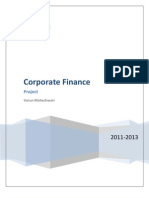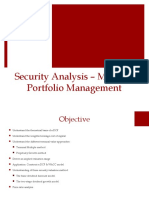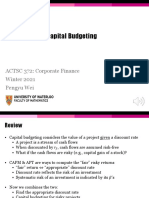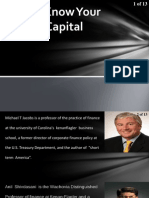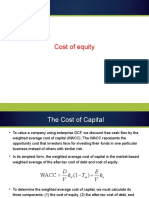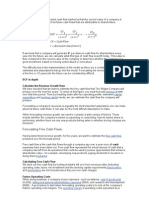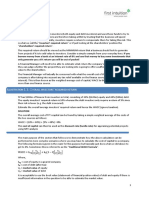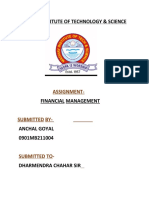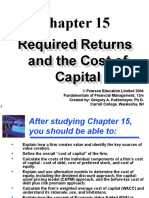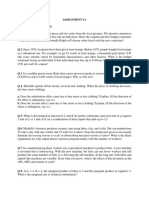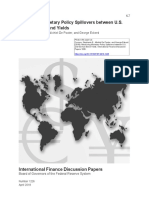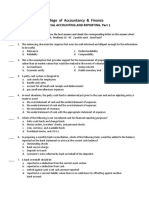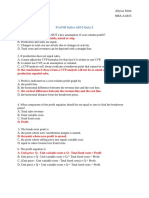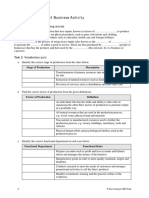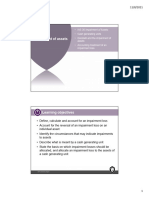Lecture 1.
Corporate Finance / Background to Financial Management
1. Corporate finance / financial management deals with three long-term and interrelated
financial decisions. These are investment and financing decisions, and dividend policy.
The objective of analyzing investment decisions is to choose projects that achieve
economic profit, as opposed to accounting profit. This is the way to maximize the
company’s stock market price.
The objective of the financing decision is to determines the debt-to-equity ratio that
minimizes the company’s cost of capital.
The objective of dividend policy is to determine the payout policy that maximizes the
company’s stock market price.
Accounting profit is simply net profit or net income or return on assets (ROA).
Economic profit, on the other hand, is return on assets minus the opportunity cost of
capital, or cost of capital, or weighted average cost of capital (WACC).
What is the WACC? Simple example to illustrate this concept.
Assume that the mean annual value (2017-2020) of total debt is equal to $100.
Assume that the mean annual value of the market value of equity is equal to $200.
In this case, the company relies on 0.333 debt ($100/$300), and on 0.666 equity
($200/$300).
In this case, the WACC is equal to: (0.333 x Cost of Debt) + (0.666 x Cost of Equity).
What is the cost of debt? It is equal to Interest Rate (1 – Tax Rate).
If a company pays 10% interest rate on its debt, and 40% tax on its profits, then it cost of
debt is equal to: 10% (1 – 0.40) = 6%. This is the case because interest is a cost and has a
tax shield (debt reduces taxes).
What is the cost of equity? The market value of equity (market capitalization + reserves +
retained earnings) belongs to the shareholders. To understand the cost of equity, it is
important to note that the company has two options:
A. It can give back its equity to its shareholders.
B. It can keep its equity. If this is the case, then the company should earn, on its equity, a
return which satisfies its shareholders at the level of the risk of the firm itself. Therefore,
to measure the cost of equity capital, one needs to understand how to calculate: The
Return on the Stock. The Risk of the Stock. The Relationship between Return & Risk!!!
�This is where the Capital Asset Pricing Model (CAPM) comes in. One needs to understand
the “rationale” of the CAPM, and how to “use” it in estimating the cost of equity capital.
2. Investment Decision / The Economics of Capital Budgeting. Net Present Value (NPV),
Payback Period, Profitability Index, and Internal Rate of Return.
One should always use the NPV method. This method relies on the concept of Cash Flow,
which is equal to:
+ Total Revenue
- Total Cost
- Depreciation
----------------------
+Gross Profit
- Taxes
----------------------
+Net Profit
+ Depreciation
----------------------
Cash Flow
Let us assume that you want to invest in fixed assets (laptop and a printer) whose initial
cost is $1,000. Assume that the life of these assets is three years. If the WACC of this
company is equal to 8%, and the project is expected to generate $400 cash flows in each
of the three years, its NPV would be equal to:
NPV = -1,000 + 400 / (1 + 0.08)1 + 400 / (1 + 0.08)2 + 400 / (1 + 0.08)3
NPV = $+30.8
What does this number ($30.8) mean? We illustrate the meaning as follows:
Amount Due WACC Cash Flow Balance
$-1,000 $-80 $400 $-680
$-680 $-54.4 $400 $-334.4
$-334.4 $-26.75 $400 $+38.8
$+38.8 is after 3 periods/years from now. The present value of this amount is 38.8 / (1
+ 0.08)3
$+30.8
In reality, if the company announces that it is going to invest in this project today, and
investors believe the news, then its current stock price would increase. By how much? If
�the number of subscribed shares is 300, then the stock price (today) would increase by
$30.8 / 300 = $0.103!!!
The overall objective of finance…… is to maximize Economic Profit. Economic Profit =
ROA – WACC!!!
The Rationale of the CAPM.
To understand the logic of this model, assume that the average investor is a “long-term”
investor, and he / she is “rational”. By rational, we mean he / she is a risk-averse investor
(higher risk? then Higher Expected Return).
a. If this is the case, then the average investor should be well-diversified.
b. If this is the case, the risk of every investor is the market risk / not diversified /
systematic risk.
To measure market risk for listed companies, one needs to regress the stock returns of a
company on the performance of the national economy (real GDP). The risk that no
company can avoid is how it is impacted by the changes in real GDP!!!
Rit = αi + βi∆GDPt + ei
The slope of this function (β) is the measure of risk (market) for any listed company.
However, to estimate this function, one needs a “good number” of observations. In other
words, to use the function, one needs a long time. Too long of a time (20 years!) is not
suitable to measure risk.
Therefore the impact of stock market index returns (as a proxy / indirect measure of the
national economy’s performance / change in real GDP) on each stock’s returns can be
used.
Rit = αi + βiRMt + ei
Where, Rit are the monthly returns for stock i during a given period t (4-5 years), and R Mt
are the monthly returns on the market index during a given period (4-5 years). In this way
(5 years and monthly returns for the stock and the index), one can have 60 observations (5
x 12).
�Here, one needs to take into account the question: Why monthly returns and for about
5 years? The estimated beta values tend to be stable. In other words, they do not
change significantly over time.
Based on the above, we can express every investor’s return by the following expression:
1. Rp = (1 – x)RF + x(RM)
where 1-x is the proportion invested in treasury bills and x is the proportion invested in
the market index. Here, you should note that the portfolio of one person might 100% in
the risk free securities (treasury bills). Another person’s portfolio, on the other hand,
might be 100% in a well-diversified portfolio (market). Another person’s portfolio might be
composed of 50% in the risk free and 50% in the market, and so on.
2. Βp = (1 – x) zero + x*1
where zero is the risk (beta) of the treasury bills and +1 is the risk (beta) of the market’s
index.
If we substitute 2 into 1, we have:
Rp = (1 – βp) RF + βp*RM Or Rp = RF + βp(RM – RF) This is the CAPM.
Now, to use the CAPM in estimating the cost of equity capital for any listed firm, one
needs to:
1. Estimate the beta of the company.
2. Calculate the mean annual risk premium (RM– RF) for the stock market (4-5 years).
3. Cost of Equity Capital = RF + βp(RM – RF)
�If the current annual RF is equal to 5%, RM – RF is equal to 10%, and the beta of the
company is equal to 1.5, then the cost of equity capital is equal to:
Cost of Equity for firm i= 5% + 1.5(10%) = 20%. This is the expected return that satisfies
the company’s “long term investors”.
Based on this, the WACC of the company is equal to:
(0.333 x 6%) + (0.666 x 20%) = 2% + 13.3% = 15.3%
This cost (WACC) should be used in the investment appraisal of any project.



